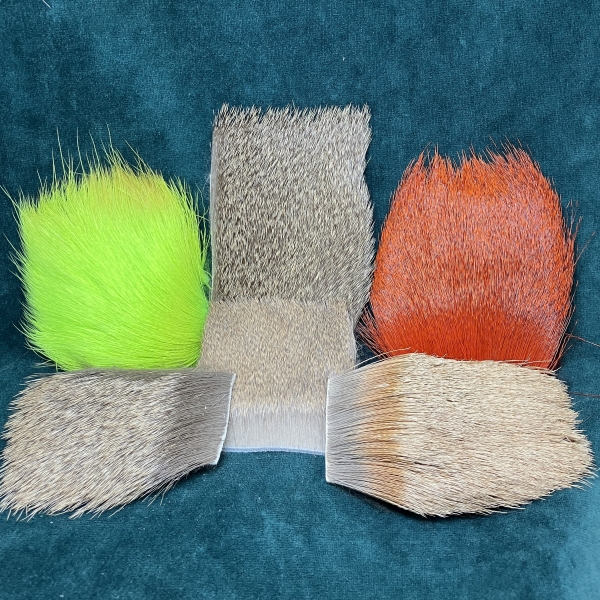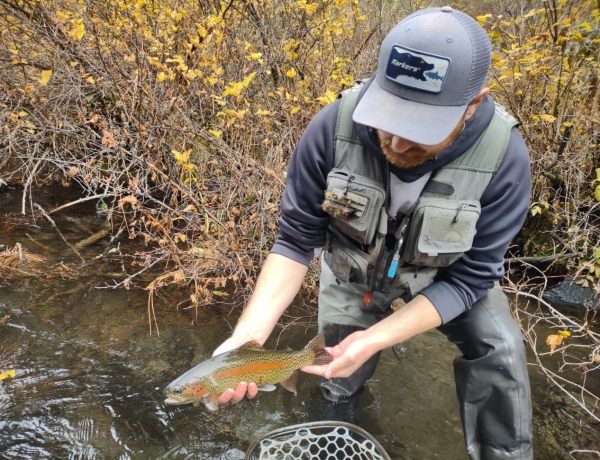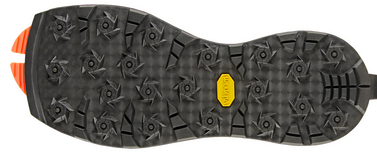If you ask people around central Oregon what their favorite time to fish locally is, a lot of them will say the fall season. The turn of the weather brings on more aggressive feeding, spawning migrations, and all sorts of other opportunities to have success on the water. It's unlikely you'll have time to fish everything, but we'll do our best to lay it out for you.
Streams
You can count me as one of those people who's favorite time to fish is the end of summer into the fall. The hardest part of this time of the year is deciding where to go. Plenty of streams have terrestrial fishing still going strong until the real cold sets in, and the lower sun angle and cooler temperatures can galvanize trout to come to the surface more readily than during the dog days of summer. October caddis pupa/nymphs and adults will be on the menu pretty much everywhere, as will smaller caddis typically sizes 14-18. PMDs wind down, and BWOs ramp up, but both can be important on any given day. Hoppers and ants can also bring fish up even when nothing is on the surface as long as the weather stays somewhat warm. Stonefly nymphs and eggs can pick up fish on the lower D pretty much any day of the year, but now is as good a time as any. Crayfish are more available to trout than usual, since they also spawn in the fall. The Metolius and Fall Rivers don't have crayfish, and the Crooked doesn't really have them either below Bowman, but the Deschutes has a lot of them throughout and they can be very fun to fish. The Metolius has all sorts of fun hatches this time of year. Please by all means come in to the shop if you want a more specific breakdown, but here's a quick list of what you could see out there on any given day: PMD/cynigmulas, PEDs, BWOs, mahogany duns, caddis from sz 8-20, yellow sallies, little olive stones, golden stones, a few mixed other large stoneflies, ants, beetles, hoppers, and everyone's favorite, midges. Fall spawning fish like bull, brown, and brook trout will be staging to spawn, and typically this makes them fickle but sometimes more aggressive. Stripping buggers or bigger streamers for these fish can be a fun way to target them. Bull trout see an influx of spawner kokanee into the Metolius around the end of September and can get really amped up to eat them. Generally, fish move upstream to spawn as well so fishing just below barriers like weirs in town or large rapids or falls can have higher concentrations of big fish this time of year.
Steelhead are in the Deschutes, and there are more of them this year than there have been in a while so check out our post on steelhead fishing if you want to target them.
Water that closes after Sept 30th:
Fall River below the falls, Deschutes above Benham Falls
Water that closes after Oct 31st:
Tumalo Creek, Whychus Creek, lower Deschutes Warm Springs side (river left from Dry Creek down to the northern boundary of the Warm Springs Tribal Reservation), Metolius above Allingham Bridge, Crooked River above Prineville Reservoir, Ochoco Creek
Lakes
The weather is warm as I'm typing this (9/19/23), but that probably won't last long. Fish are acutely aware of the coming changes, and will be aggressively feeding until the winter. Callibaetis and caddis will stick around as long as the hot weather does, but once that goes they're not much of a factor any longer. Terrestrial season on the lakes can go a little later than callibaetis, but if it gets cold then that stuff is off the menu soon after the callibaetis are. Leeches and chironomids, as usual, are on the menu and the fish normally get less selective on these flies as the season winds down. Water boatmen can be a sneaky good fly sometimes. Having a few in your box to try on an intermediate line when the weed lines begin to recede can be a day-saver. Nymphs of damsels and callibaetis are always around even if the adults aren't. Bass can be fished later than you might think, but once the water temperature dips below 65 they get less and less active. Browns and brook trout will attempt to spawn to varying degrees of success in lakes without inlet streams, and like in the previous section this can make them fickle if you can see them milling around in the shallows. Tiger trout, though sterile, curiously will go through the motions of spawning too sometimes so you might see them near the shore or in tributaries being weird with the other species of trout. ODFW stocks tigers in Diamond and Fish Lake (near Lake of the Woods in southern Oregon), but a few that could be wild or could be hatchery mix-ups have been caught in Paulina and East over the years.
Lakes that close after October 31st:
Crane Prarie, Metolius Arm of Lake Billy Chinook, Odell Lake, Wickiup Reservoir


